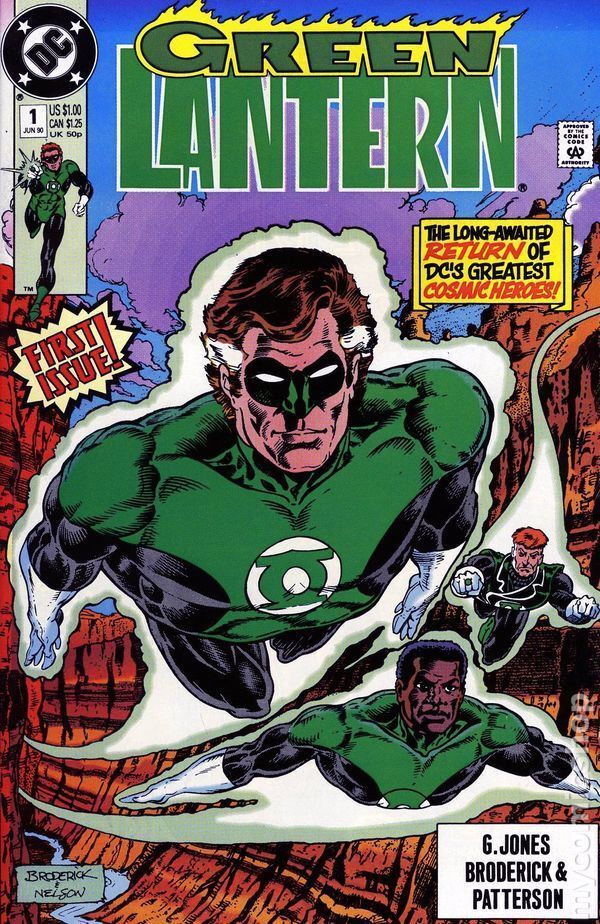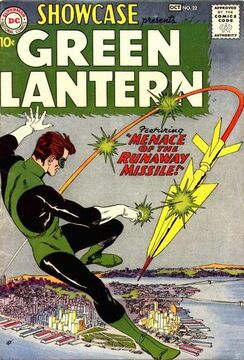The two different Green Lantern legacies have had successful series and several spin-offs since 1940.
History
Golden Age
The original Golden Age Green Lantern was Alan Scott, created for All-American Publications in 1940 by Martin Nodell and Bill Finger. The character's first appearance and origin was told All-American Comics #16, an anthology title. Scott was a railroad engineer (who would, later in the series, transition into broadcasting) who discovered a magic jade lantern. From this lantern he crafted a ring that gave him a variety of powers once "charged" by the lantern itself, although the charge would only persist for 24 hours at a time and the ring's powers were ineffective against anything made of wood.[1] The Green Lantern quickly became the lead feature of All-American Comics, and would appear in every issue through October 1948's issue #102, after which the series was overhauled into a western title and all superhero characters were dropped.
The popularity of the character led to his inclusion in All-Star Comics (Volume 1), another All-American Publications anthology title, albeit one that also featured properties from All-American's sister company, National Periodical Publications. The first Green Lantern story to be published in All-Star Comics appeared in All-Star Comics #2. The very next issue saw the premiere of the Justice Society of America, the first superhero team, with Green Lantern as a charter member. Initially the Justice Society was little more than a framing device for each issue of All-Star Comics, with the team's members splitting up to have solo adventures before reassembling at the conclusion of each issue.
Initially intended as a showcase for All-American and National Periodical's second-tier characters, those who were popular enough to warrant a second regular feature, but not popular enough to justify an solo book of their own (as was the case with characters like Superman and Batman), All-Star Comics (and the Justice Society) continued to feature Green Lantern only through its eighth issue. At that point, the character was deemed successful enough to justify a solo title, Green Lantern (Volume 1), the first issue of which was published in September 1941 and would run for most the remainder of the decade, ending with issue #38 in October 1949.
March 1945 marked a change in editorial direction for All-Star Comics and the Justice Society of America. All-American Publications had briefly split with National Periodical Publications, leading to the sudden removal of the characters owned by the latter from the title. As a result, both The Spectre and Starman (National Periodical-owned characters) abruptly vanished from the book's roster and were replaced with former "honorary" members the Flash and Green Lantern (both All-American characters) with All-Star Comics #24. Although this rift between the two publishers would quickly be resolved with National Periodical's purchase of All-American, the line-up change it caused would become permanent.
Eventually, the loose framing structure of Justice Society stories were dropped in favor of genuine team-up tales, and it would be in this form that the Golden Age Green Lantern would survive in print the longest. He remained a main character there until All-Star Comics #57 in March 1951, the final issue of the title, one of the final victims of the slow decline in popularity of superhero comics following World War II.
Silver Age
John Broome and Gil Kane updated the Green Lantern concept during the Silver Age by creating Hal Jordan in 1959. He was a test pilot given his ring and power battery by the dying alien Abin Sur who crashed to Earth in a spacecraft. Instead of wood, this ring had a weakness to the color yellow. Jordan worked at Ferris Aircraft where he was in love with the boss' daughter Carol Ferris, in love with Green Lantern but unaware of his double identity.[2] Following a three-issue stint in Showcase he was used as a founding member of the Justice League.[3] They quickly gave Jordan his own Green Lantern series, which established him as a member of the Green Lantern Corps led by the Guardians of the Universe on Oa.[4]
To give him a kid sidekick, the Eskimo mechanic Pieface was introduced as his confidante.[5] His arch-nemesis Sinestro was later created as a renegade ex-Lantern wielding a Yellow Lantern Ring made by the Weaponers of Qward.[6] Carol Ferris later becomes another one of his enemies when she's turned into Star Sapphire.[7]
They later introduce another Lantern of Earth named Guy Gardner, an equally qualified candidate who would've been chosen if Jordan hadn't been closer. Gardner is supposed to replace Jordan if he is ever unable to complete his duties.[8]
Bronze Age
The '70s
In the Bronze Age, Dennis O'Neil and Neal Adams were given the title to fight diminishing sales. They chose to politicize his adventures, teaming law-and-order hero Green Lantern with his liberal best friend Green Arrow. When Green Arrow accused the Guardians of losing perspective, a Guardian named Appa Ali Apsa, a.k.a., "Old Timer," agreed to accompany them on a road trip across America.[9] When Guy Gardner injures himself, Hal is forced to train another potential replacement. This man is a black architect named John Stewart, who stepped in as Green Lantern's substitute in some occasions.[10] Dennis O'Neil's run lasted for almost the entirety of the '70s, and one of his last storylines involved Guy Gardner getting kidnapped by Sinestro, which left Guy in a catatonic state, something that would pay off years later.[11]
The '80s
Following O'Neil's run, the beginning of the '80s saw different writers stepping in to write short runs in the Green Lantern title, like Marv Wolfman, Mike W. Barr, and Len Wein, who also wrote the miniseries Tales of the Green Lantern Corps. It's during this time that Hal Jordan was accused by the Guardians of being negligent by focusing too much on Earthly matters (mostly related to his work at Ferris Aircraft) and ignoring the problems of other planets in his Sector. As punishment, he was forced to go on a one-year-long exile from Earth, learning to see things from different points of view.[12] Another major turning point happened shortly after Hal's return to Earth when he resigned from the Corps, and John Steart was called again to wear the ring, this time as a full-time Green Lantern.[13]
During the final issues of Green Lantern Volume 2, written by Steve Englehart, the Corps was affected by the Crisis on Infinite Earths. While John was recruited by the Monitor, the Guardians decided to bring back another Green Lantern to carry on a most crucial mission: Guy Gardner, who just woke up from his coma. This caused Hal Jordan to grow desperate to return to the Corps, and by the end of the storyline he earned his ring back, following the death of Tomar-Re.[14]
Post-Crisis

Following the Crisis on Infinite Earths, the Guardians left our dimension to partner with their mates the Zamarons.[15] This upheaval in organization allowed Lanterns to choose their own assignments based on need, and a large group assembled as the Green Lantern Corps of Earth.[16] The Green Lantern title was renamed Green Lantern Corps, and it followed Hal Jordan's team on Earth. This group eventually disbanded when the Corps executed Sinestro, which ignited a chain reaction that ended with the destruction of the Central Power Battery of Oa.[17] With a total of 224 issues, the series was brought to an end, remaining as the longest ongoing series in Green Lantern's history.
Green Lantern was moved as a backup title in the series Action Comics Weekly. Following Hal Jordan on Earth, this issues had stories like Katma Tui's death[18], Hal figuring out if he was truly fearless, joining a new team of aircraft designers, teaming up with Captain Atom to deal with an alien, and facing Lord Malvolio, although most of these stories were ignored and never went further than a few mentions in subsequent series.

The '90s
By the time of Hal Jordan's 30th anniversary, Green Lantern returned to its solo title with the mini-series Emerald Dawn (and its sequel), which updated Hal Jordan's origin for Post-Crisis continuity. Following that mini-series, Green Lantern was finally given a new ongoing series again headlining Jordan, helmed by writer Gerard Jones. During the first issues of that run, the Green Lantern mythos was restored: the Guardians returned to Oa, the Central Battery and the Corps were rebuilt, and all three human Green Lanterns had a level of importance: Guy Gardner staying on Earth with the Justice League; Hal Jordan recruiting new members for the Corps, and John Stewart taking care of the "Mosaic World" on Oa.[19] Eventually, Hal Jordan returned to Earth and kicked Guy out of the Corps[20], who then decided to steal Sinestro's power ring and follow his own path, free of the Corps' restrictions.[21]
All three human Green Lanterns had their own ongoing series published simultaneously for a time: Hal Jordan in Green Lantern; John Stewart in Green Lantern: Mosaic, and Guy Gardner on his homonymous series, which eventually turned into Guy Gardner: Warrior.
Emerald Twilight/New Dawn
Due to low sales, DC decided to wipe out the entire Green Lantern Corps and start over with an entirely new character. Hal Jordan went insane during the Emerald Twilight storyline and became Parallax, murdering the Guardians and destroying the Central Power Battery. Ganthet gives their final ring to an artist named Kyle Rayner as the last Green Lantern.[22] Rayner's girlfriend Alex DeWitt is killed by super-villain Major Force very early on, giving him motivation through tragedy.[23] Hal Jordan died to save the world as Parallax during The Final Night.[24] His soul remained in Purgatory, and this allowed him to become the new Spectre during Day of Judgment.[25]
Rebirth
Hal Jordan is resurrected to become Green Lantern again during the Rebirth storyline by Geoff Johns. It's revealed that Parallax was an evil entity who possessed him, the living embodiment of fear on the emotional electromagnetic spectrum.[26] The Green Lantern Corps is rebuilt during the Recharge storyline.[27]
Related Articles
- Green Lantern Recommended Reading
- Green Lantern (Volume 1)
- Green Lantern (Volume 2)
- Green Lantern (Volume 3)
- Green Lantern (Volume 4)
- Green Lantern (Volume 5)
- Green Lantern (Volume 6)
- Green Lantern (Volume 7)
- The Green Lantern (Volume 1)
- The Green Lantern: Season Two (Volume 1)
- Green Lantern Corps (Volume 1)
- Green Lantern Corps (Volume 2)
- Green Lantern Corps (Volume 3)
- Green Lantern: Emerald Warriors (Volume 1)
- Green Lantern: New Guardians (Volume 1)
- Green Lanterns (Volume 1)
- Hal Jordan and the Green Lantern Corps (Volume 1)
Links and References
Footnotes
- ↑ All-American Comics #16
- ↑ Showcase #22
- ↑ The Brave and the Bold #28
- ↑ Green Lantern (Volume 2) #1
- ↑ Green Lantern (Volume 2) #2
- ↑ Green Lantern (Volume 2) #7
- ↑ Green Lantern (Volume 2) #16
- ↑ Green Lantern (Volume 2) #59
- ↑ Green Lantern (Volume 2) #76
- ↑ Green Lantern (Volume 2) #87
- ↑ Green Lantern (Volume 2) #123
- ↑ Green Lantern (Volume 2) #150 - #172
- ↑ Green Lantern (Volume 2) #181 - #182
- ↑ Green Lantern (Volume 2) #194 - #198
- ↑ Green Lantern (Volume 2) #200
- ↑ Green Lantern Corps #201
- ↑ Green Lantern Corps #222 - #224
- ↑ Action Comics #601
- ↑ Green Lantern (Volume 3) #13
- ↑ Green Lantern (Volume 3) #25
- ↑ Guy Gardner Reborn #1 - #3
- ↑ Green Lantern (Volume 3) #50
- ↑ Green Lantern (Volume 3) #54
- ↑ The Final Night #4
- ↑ Day of Judgment #5
- ↑ Green Lantern: Rebirth #1
- ↑ Green Lantern Corps: Recharge #1
